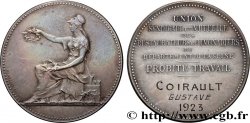fme_466446 - III REPUBLIC Médaille commémorative interalliée de la Victoire, Grande Guerre 1914-1918
Not available.
Item sold on our e-shop (2019)
Price : 50.00 €
Item sold on our e-shop (2019)
Price : 50.00 €
Type : Médaille commémorative interalliée de la Victoire, Grande Guerre 1914-1918
Date: 20/07/1922
Date: 1922
Mint name / Town : France
Quantity minted : 2.000.000
Metal : bronze
Diameter : 35 mm
Orientation dies : 12 h.
Engraver MORLON Pierre-Alexandre (1878-1951)
Weight : 20,55 g.
Edge : Lisse
Coments on the condition:
Exemplaire avec sa bélière et son ruban d’origine. Présence de coups. Légère usure sur les points hauts.
Obverse
Obverse legend : ANÉPIGRAPHE.
Obverse description : Victoire ailée et laurée, drapée à l’antique, portant l’épée à droite et tenant dans chaque main tendue des couronnes de lauriers ; Nom du graveur en bas à droite : A. MORLON.
Reverse
Reverse legend : R - F / LA / GRANDE GVERRE / POVR LA / CIVILISATION / 1914-1918 / -.
Reverse description : Inscription en 6 lignes, avec un bonnet phrygien et couronne civique entre les deux lettres RF.
Commentary
Cette médaille, dite “médaille de la Victoire”, a été créée suite à la loi du 20 juillet 1922. Elle concerne tous les militaires ayant servi trois mois entre le 2 août 1914 et le 11 novembre 1918 dans la zone des armées.
Par ailleurs, l'article 10 de la loi de 1920 précise que : Le droit de la médaille est également acquis aux militaires qui ont été tués à l’ennemi ou qui sont morts des suites de blessure de guerre (…) et à ceux qui sont morts de maladies ou blessures contractées en service.
La médaille avait été réclamée par le maréchal Foch, commandant en chef des troupes alliées à la fin de la guerre, qui avait proposé la création d’une médaille commémorative commune à toutes les Nations belligérantes alliées.
source : https://fr.wikipedia.org/wiki/M%C3%A9daille_interalli%C3%A9e_1914-1918.
Par ailleurs, l'article 10 de la loi de 1920 précise que : Le droit de la médaille est également acquis aux militaires qui ont été tués à l’ennemi ou qui sont morts des suites de blessure de guerre (…) et à ceux qui sont morts de maladies ou blessures contractées en service.
La médaille avait été réclamée par le maréchal Foch, commandant en chef des troupes alliées à la fin de la guerre, qui avait proposé la création d’une médaille commémorative commune à toutes les Nations belligérantes alliées.
source : https://fr.wikipedia.org/wiki/M%C3%A9daille_interalli%C3%A9e_1914-1918.








 Report a mistake
Report a mistake Print the page
Print the page Share my selection
Share my selection Ask a question
Ask a question Consign / sell
Consign / sell
 Full data
Full data









